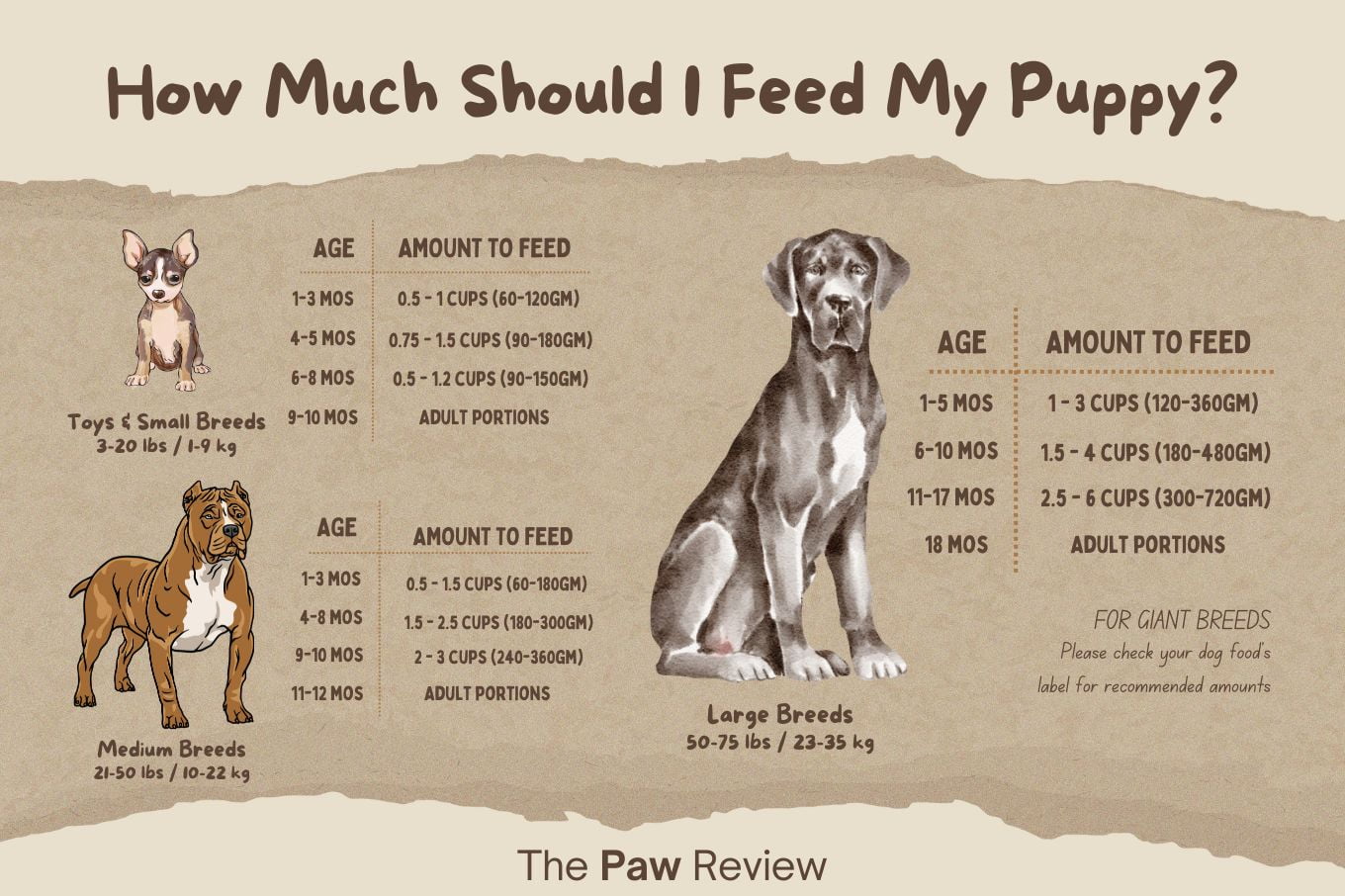This post may contain affiliate links, which means we may receive a commission from purchases made through these links. See our affiliate disclaimer.
The first year of a puppy’s life is one of rapid growth, and they’ll need adequate nutrition to help them reach their growth potential during this crucial phase.
Below we answer some important questions regarding a puppy’s nutrition, including the one you’ve come here for — how much should I feed my puppy?
When should puppies start eating puppy food?
For the first 4 weeks of their lives, a puppy’s primary source of nutrition should be their mother’s breast milk. This milk is rich in all the macronutrients, vitamins and minerals a puppy needs during their newborn period.
Puppies can be given some puppy food starting at 4 weeks old, while still getting breast milk from their mother. Mixing the food with some puppy milk replacers is a good way to help them transition to solid food. By 6 weeks of age they can be maintained solely on commercial puppy food.
How much should I feed my puppy?
As a rough guide, 9 grams per pound of bodyweight (or 20 grams per kg) is an appropriate amount of dry food to feed your puppy.
We go into further detail on this in the puppy feeding chart below. The chart is meant to be used only as a general guide, as the appropriate amount of food depends heavily on the brand of food you’ve bought. Do check the label on your bag of dog food or the manufacturer’s website for their recommendations.
By weight
The amounts listed here are totals for a whole day of feeding, which should be divided into 2-4 meals a day (more on that below). This infographic contains the recommended amounts of food, stated in both cups and grams, based on your puppy’s breed size, weight and age.

For giant-breed puppies — those weighing more than 75 pounds (35 kg) — we highly recommend checking the label on your bag of dog food or the manufacturer’s website for feeding amounts. Puppies of this size are particularly prone to problems such as under- or overfeeding, and the recommended amounts to feed vary significantly based on a puppy’s size & breed.
Watch the dog, not the dish
While having fixed values is helpful as a guide, your dog’s appearance and behavior can sometimes provide more helpful information. If you notice he’s getting a bit hefty and perhaps having a hard time jumping on & off the couch, he may be gaining too much weight and you can consider cutting back on his food. Investing in a weighing scale to monitor his weight is also a good idea.
Your dog’s weight, the amount of food he leaves in his bowl, skipping a meal despite being in good spirits — these are some important clues that can guide his feeding.
How often should I feed my puppy?
Puppies generally need to eat more frequently in their earlier months. Smaller portions throughout the day are easier to digest, and they burn through it just as quickly because they’re so playful. Once they’re older their stomachs will be able handle larger portions.
If you’re not able to follow a frequent feeding schedule, worry not! Puppies can adapt to twice a day feedings as long as they get the recommended total amount of food per day. Alternatively, you can consider using an automatic feeder that dispenses food on a set schedule.
What kind of food is best for puppies?
The important thing to look for here is the AAFCO statement of quality. Any commercial puppy food that has the AAFCO seal is sure to be a complete and balanced diet. You can usually find it on the back of the label, next to the ingredients and other nutrition information.
The AAFCO sets the standards for quality & safety of pet food. Dog food manufacturers adhere to these standards, and can only print the AAFCO seal once their food products have gone through the proper safety & quality checks.
How much water should a puppy drink?
The short answer: about one ounce of water per pound of bodyweight (approximately 15ml per kg).
The long answer: it depends a lot on your puppy’s age, size & activity level, plus the climate where you live. Newborn puppies (0-3 weeks of age) get everything they need, including hydration, from their mother’s breast milk.
Once they start weaning & until they’re completely weaned off breast milk, they’ll need a steady supply of fresh water. About 0.5 to 1 ounce per pound of body weight per day (approximately 7-15 ml per kg).
This can go up or down depending on how energetic your puppy is and how hot it is where you live. A good way to check on your puppy’s hydration is to look at his urine. As long as he’s peeing freely and his urine is light yellow, he’s almost surely well-hydrated.
When to switch from puppy food to adult dog food
When he reaches 80% of his expected adult size, your puppy can be switched over to adult dog food.
However, the answer to this also depends on your puppy’s breed, activity level and whether he or she has been spayed or neutered. To read the more detailed answer, check out our article linked below.

